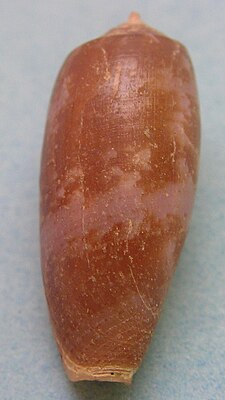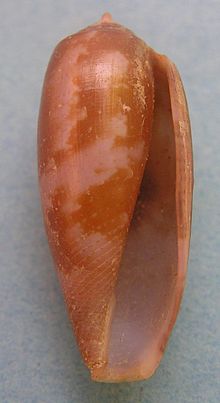Conus obscurus
| Conus obscurus | ||||||||||||
|---|---|---|---|---|---|---|---|---|---|---|---|---|

Housing of Conus obscurus |
||||||||||||
| Systematics | ||||||||||||
|
||||||||||||
| Scientific name | ||||||||||||
| Conus obscurus | ||||||||||||
| GB Sowerby I , 1833 |
Conus obscurus ( "dark cone") is the species name of a screw from the family of the cone snails (genus Conus ), which in Indopazifik is widespread and fish eats.
features
Conus obscurus carries a moderately small to medium-sized, light to moderately light snail shell , which reaches 2.5 to 4.5 cm in length in adult snails. The circumference of the body is cylindrical to narrowly cylindrical, the outline almost straight, on the left side in the quarter to third slightly concave at the base. The case mouth is wider at the base than it is next to the shoulder. The shoulder is angled. The thread is usually medium high, its outline straight or slightly concave. The Protoconch has 3 ¼ to 4 whorls and measures a maximum of about 1 mm. These first 2 to 4 whorls of the teleoconch are covered with tubercles. The seam ramps of the Teleoconch are flat to slightly concave with 1 to 4 to 6 increasing larger spiral grooves, sometimes up to 8 finer grooves, whereby the sculpting on the late seam ramps is mostly weak. The perimeter of the body has a few weak spiral ribs at the base.
The body is greyish-blue to purple. From the base to the shoulder there are alternating, conspicuous spiral rows of alternating brown and gray dots and lines. Brown flames, clouds and spots are mostly concentrated in spiral bands on the shoulder, just behind the center and within the third at the base. The whorls of the Protoconch are red to orange. The seam ramps of the first whorls of the Teleoconch are gray, often with dark brown dots on both edges of the first whorl and drawn with brown radial lines and stripes on the following whorls. The seam ramps of the later whorls are bluish-gray with confluent brown radial spots and often completely overlaid with brown. The case mouth is translucent or has a thin white coating.
The very thin, translucent, smooth periostracum is yellow.
The top of the foot is white to pink and thickly covered with dark yellow to reddish-brown spots. The pattern consists of inconspicuous spots and longitudinal bars in the middle, while white elements unite at the edge. The sole of the foot is pink with light brown spots. The rostrum is pink with densely packed brown axial stripes or completely brown. The antennae are white and can be spotted brown. The sipho is white or pink with densely packed reddish-brown horizontal stripes on underlying brown spots or completely brown, the tip white with a pink or yellow edge.
The radula teeth connected to a poison gland have two small barbs in a row at the tip and opposite a third, long barb with an alternately sharply pointed rear end. A serration and a spur at the base are missing.
distribution and habitat
Conus obscurus is common in the Indo-Pacific from the coast of East Africa and KwaZulu-Natal to French Polynesia and Hawaii , but is absent in the Red Sea.
It lives in the intertidal zone, but more often below it to depths of below 40 m, often on coral reefs, on coral rubble between seaweed and on sandy surfaces, but also on rocky surfaces in the surf.
Development cycle
Like all cone snails, Conus obscurus is separate sexes, and the male mates with the female with his penis . The female lays egg capsules with numerous eggs. The eggs in it are around 147 µm in size in Hawaii , from which it is concluded that the Veliger larvae swim free for at least 28 days before they sink down and metamorphose into crawling snails .
food
Conus obscurus feeds on fish that are killed by being stabbed once with the poisonous tooth and get caught on the harpoon. The poison acts on fish in a matter of seconds and leads to injuries similar to a bee sting in humans. The prey is swallowed within a few seconds. Conus obscurus is the smallest species of the fish-eating subgenus Gastridium .
literature
- Dieter Röckel, Werner Korn, Alan J. Kohn: Manual of the Living Conidae Vol. 1: Indo-Pacific Region . Verlag Christa Hemmen, Wiesbaden 1995. The texts on the individual cone snail species of the Indo-Pacific are published on The Conus Biodiversity website with the permission of the authors (see web links).
Web links
- The Conus Biodiversity website: Conus obscurus Sowerby ii, 1833
- Underwater Kwajalein: Conus obscurus Linnaeus, 1758
Individual evidence
- ↑ Baldomero M. Olivera, Jon Seger, Martin P. Horvath, Alexander E. Fedosov: Prey-Capture Strategies of Fish-Hunting Cone Snails: Behavior, Neurobiology and Evolution. In: Brain, behavior and evolution. Volume 86, number 1, September 2015, pp. 58-74, doi : 10.1159 / 000438449 , PMID 26397110 , PMC 4621268 (free full text) (review).
